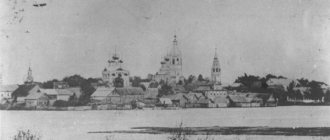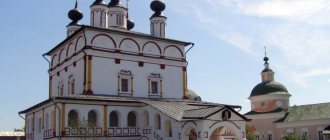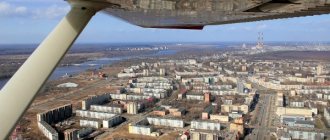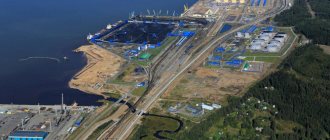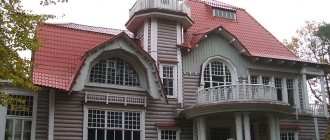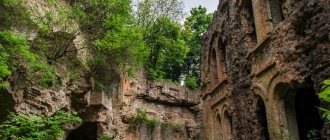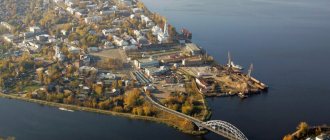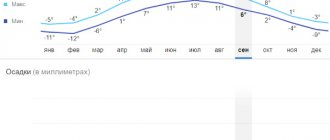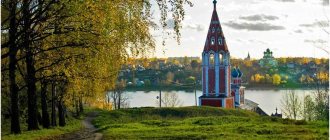| Porkhov |
Porkhov
, a city in Russia, the administrative center of the Porkhov district of the Pskov region, the second cathedral city of the Pskov diocese. Located in the Shelonskaya lowland, on the river. Shelon (the basin of Lake Ilmen), 3 km from the railway station of the same name on the Bologoe-Pskov line, 88 km east of the regional center. Population - 8.9 thousand people. (2017).
- On the map: Yandex.Map, Google map
The city was founded in 1239 by the noble prince Alexander Yaroslavich (in the future - Nevsky) when creating a system of fortresses on the Shelon River along the border of the Novgorod land. The fortifications had the appearance of an irregular pentagon, repeating the contours of the hill they occupied. The name of the city is derived from the noun porkh
("gunpowder") or the personal name
Porkh
. The town became a key defense point on the borders with the Principality of Lithuania. In 1346, the city withstood a siege by the troops of the Lithuanian prince Olgerd.
The original wood-earth fortress was destroyed by fire and in 1387, at a city meeting, the Novgorodians decided to move the fortress to a new location. On the western side, the approaches were covered by the bed of the Sheloni River, on the east by a wide ditch, and on the north the fortress was adjacent to a swampy lowland, impassable in rainy times. A new city center was formed in the new stone fortress. In 1428, the city again withstood the siege of the Lithuanian troops of Prince Vytautas. In 1430, the city fortress was reconstructed.
In 1478, along with the entire Novgorod land, Porkhov became part of the Moscow state and became a grand-ducal fiefdom. At that time it was considered one of the 12 most reliable fortresses of the Russian land. In 1581, the city was besieged by the Polish troops of Stefan Batory. During troubled times, in 1611-1617, the fortress was captured by the Swedes.
Since 1708, Porkhovsky district became part of the Ingermanland (since 1710 - St. Petersburg) province. Since 1719 - as part of the Novgorod province (since 1727 - in the Novgorod province of the Novgorod province). In 1777 it was designated a district town of the Pskov governorship (since 1796 - Pskov province). Since the 18th century, it has been a famous flax trading center.
On August 1, 1927, the Porkhovsky district with its center in Porkhov was formed as part of the Pskov district of the Leningrad region. During the Great Patriotic War, the city was occupied by Nazi troops from July 11, 1941 to February 26, 1944. The occupiers set up a concentration camp “Dulag-100” near Porkhov. Before the retreat of fascist troops from the city, over 90% of its buildings were blown up.
Since August 23, 1944, Porkhov has been the regional center of the Pskov region. In October 1959, the abolished Slavkovsky district and the southern part of the abolished Pavsky district were transferred to the Porkhovsky district. During the post-war reconstruction, the city largely lost its pre-war appearance. At the same time, the perimeters of the walls of the 14th century have been preserved in the old fortress; Small, Middle and Nikolskaya towers; the remains of a moat and the St. Nicholas Church, erected on the site of the old St. Nicholas Church near the tower of the same name in the 18th century. At the beginning of the 21st century, a lime and cheese-making factories, a forestry enterprise, and a pig-breeding complex operated in Porkhov; there were two secondary schools, a speech boarding school, a branch of the Dedovichi Agricultural College, a children's art school, a social shelter, an interdistrict hospital, a central district hospital, a House of Culture, a stadium, a local history museum, a cinema, a House of Crafts, an evening school, a Children's Creativity Center, a printing house and editorial office of the newspaper "Porkhovsky Vestnik".
Statistics
- 1856 - 5.9 thousand people, 7 churches, 571 houses, 74 shops
- 1897 - 5.6 thousand people
- 1926 - 8 thousand people
- 1959 - 7.6 thousand people
- 1979 - 13.4 thousand people
- 1992 - 14.4 thousand people
- 2010 - 11.1 thousand people
The importance of the city in the modern world
The fortification “Porkhovsky town” was erected in the middle of the 13th century on the Shelon River by order of the Novgorod prince Alexander, later nicknamed Nevsky. A wooden detin with an earthen embankment was part of the defensive lines that protected Veliky Novgorod from the enemy from the west.
Why was the fortress called Porkhovskaya? The most reliable answer is this: Prince Alexander personally chose a strategically advantageous place for its installation on a high bank of the river, where there was dust in the air from limestone mined in the surrounding area (flutter - ashes, dust). But there are other, no less interesting assumptions.
At the end of the 14th century, given the enormous importance of the Porkhov fortress in the security of the Russian land, stone walls and towers were erected. This was done on time, because on his next campaign against Novgorod, the Lithuanian prince had already used a new military weapon - artillery.
The destroyed walls were periodically restored, and Porkhov continued to stand guard on the border lines, being one of the 12 main fortresses of the Russian state. By the 15th century, settlements began to appear next to the stone walls, and in 1777 the settlement was declared a county town.
Porkhov, whose sights may be of interest to tourists, is located 88 km east of Pskov. And nearby, just 10 km from it, there is the Khilovo balneological resort, known since the mid-19th century, which received the name “Northern Matsesta” for its unique hydrogen sulfide springs and mud. Porkhov coordinates: 57°46′00″ N. w. 29°33′00″ E. d.
City museums and exhibitions
Porkhov Museum of Local Lore
- Address: Lenin Ave., 5.
The main museum complex of Porkhov was founded in 1918 at the request of workers and is located in the former house of the merchant Zatsky. At that time, the basis of his expositions were the values from the surrounding numerous noble estates. During the occupation of the town by fascist troops, it was mercilessly plundered.
Now there are more than 10,000 exhibits here - you can view them either independently or by booking an excursion. The museum also has its own creative workshop “Vernissage”, where master classes on weaving and weaving are held and visitors are introduced to the history of these crafts. The museum has four branches.
House of History of the Porkhov Region
- Address: Porkhov Fortress.
The Porkhov Museum of Regional History is an integral part of the Kremlin. As the name itself says, in it you can learn in detail everything about the past of the city and region, see household items, tools, and look at paintings depicting historical buildings and streets of Porkhov that have not survived to this day.
House of Military Glory
- Address: Porkhov Fortress.
The House of Military Glory houses an exhibition dedicated to the years of the Second World War, the Porkhov underground and the partisan movement. The territory of this Porkhov attraction will be especially interesting for high school students and students, as reviews on the Internet say. And the photos of the collections posted here confirm this.
Postal Museum
- Address: Starorusskaya street.
It is a small museum corner created in 2009 and dedicated to the history of the postal service since the time the first postal route was opened in Russia. Among the exhibits of this unusual museum you can see:
- old letters,
- historical documents and photographs,
- postal supplies,
- means of transportation of postmen of different times.
Children will especially enjoy this place, as they can try to write a real letter in ink, just like they did in the old days.
House of Crafts
- Address: Lenina, 5a.
The House of Crafts is a branch of the Museum of Local Lore and is a cultural and creative center located on the territory of the Park of Culture and Recreation of the city of Porkhov. For many years, craftsmen passed on the secrets of their crafts from their grandfathers to their great-grandchildren, thanks to which they have come down to us.
The creative center offers visitors an exhibition of exhibits of various types of folk crafts of the 19th century, characteristic of this region - such as icon painting, blacksmithing, wood carving, stucco, mosaic, jewelry, etc.
This attraction hosts master classes where visitors can take an active part and master the rare skills of lace making, fillet embroidery, birch bark, grass and wicker weaving, and weaving. Exhibitions and sales are often held here, where they offer to purchase unique products of folk craftsmen.
Showroom
- Address - st. Profsoyuznaya, 2.
The exhibition hall in Porkhov is considered the most elegant in the entire Pskov region. Here visitors will be able to see the permanent exhibition “Noble Estates of Porkhov District”, as well as other exhibitions on various topics, purchase souvenirs, various booklets and tourist maps of the town.
Climate
The climate in the Pskov region is temperate, transitional from maritime to continental, which is characterized by mild winters with slight frosts and warm summers.
Daily air temperature in Porkhov (0C), precipitation (mm), number of sunny days:
| Jan. | Feb. | March | Apr. | May | June | July | Aug. | Sep. | Oct. | Nov. | Dec. |
| -5 | -3 | +1 | +9,5 | +18 | +21 | +24 | +22,5 | +16 | +7,5 | +2,5 | -2 |
| 26 | 23 | 17 | 22 | 26 | 33 | 34 | 31 | 25 | 33 | 28 | 24 |
| 1 | 0 | 3 | 10 | 19 | 16 | 15 | 20 | 12 | 8 | 4 | 1 |
The calculated comfort factor ranges from 2.5 to 5. The best time to visit Porkhov is considered to be from May to September, with the maximum 5 points occurring in the 3 summer months.
Temples of the city of Porkhov
Porkhov is an ancient city, so it has several ancient temples and cathedrals that are worth visiting when exploring this part of the Pskov region.
St. Nicholas Church
- Address: Porkhov Fortress.
St. Nicholas Church is located on the square of the Porkhov Kremlin. It was built in the 15th century and is a wonderful example of ancient architecture. It contained such relics as a cross with the relics of the Kiev-Pechersk saints and an icon of St. Nicholas the Wonderworker. At the beginning of the last century, after the Revolution, the cross disappeared without a trace, and the image can still be seen in the Pskov .
Church of the Transfiguration of Our Lord
- Address – Zavodskaya, 3a.
This temple is an architectural monument of the 18th century. It was erected near the burial place of Prince Roman Yuryevich on a hill on the banks of the Shelon River. The Transfiguration Church is active; regular services are held there and a Sunday school operates.
Church of the Nativity of the Virgin Mary
- Address: Karl Marx, 40.
The Church of the Nativity of the Mother of God was erected at the beginning of the 14th century. It is the only monument of Novgorod architecture in the Pskov region. A long time ago, within its walls there was a convent, and it itself was its cathedral church.
In 1764, this monastery was abolished by Empress Catherine and the church became a parish. In 1930 it was closed, and during the Second World War it was turned into a fire department. Then it housed first sports and then dance clubs. In 1991, the parish was returned to Orthodox believers.
Church of the Nativity of John the Baptist
- Address - st. Pskovskaya.
The Church of the Nativity of John the Baptist is an architectural monument of the early 19th century, erected at the expense of the local merchant F.N. Kirkina. We are talking about the Orthodox cemetery parish, the only one in Porkhov that worked during the period of Soviet power. Today it is also active.
Population
In the 90s of the last century, about 15 thousand people lived in Porkhov. With the onset of the crisis, the number of residents began to gradually decline, which continues to this day.
Today 8.5 thousand people live here, the main nationality of which is Russian.
Flora and fauna
The Porkhovsky district, which includes about 500 settlements, belongs to the basin of Lake Ilmen and Lake Pskov. The Shelon and Cherekha rivers flowing through it have 33 and 25 tributaries, respectively. It’s not for nothing that the Pskov region is called the land of rivers and lakes.
The mineral resources in this area include limestone (non-metallic) and peat. Forests, mainly pine, occupy more than 250 thousand hectares. All these conditions determine the flora and fauna of the area.
The water resources of the Porkhovsky district are natural fishing grounds. Here you can find pike perch, pike, perch, ide, catfish, burbot and so on. A lucky fisherman will catch an eel here, a fish that is extremely sensitive to the purity of the water. This also speaks about the state of the environment in the area. There are species listed in the Red Book (brook trout, European grayling, sculpin).
More than 150 species of higher plants grow in forests and wetlands, 16 of algae alone. Many are protected, such as snowdrops, lilies of the valley, and lady's slipper. The places are rich in berries and mushrooms, and there are a lot of cranberries in the swamps.
Fans of walks through the thicket should keep in mind that lynxes still live in the Pskov region, almost extinct in the country. There are also wolves, foxes, and hares. Birds include white-tailed eagles, kingfishers, swans and storks. This is only a small list of representatives of the flora and fauna of the Porkhov region.
Don't miss the most popular article in the section: Metro Nizhny Novgorod. Diagram, map, description.
What else is worth seeing in Porkhov
Social and cultural complex
- Address: Lenina, 14a.
The main cultural and entertainment life of the town takes place in the Porkhov Social and Cultural Complex. All the main festive and special events of the city are held at this site. Leisure activities for residents and tourists are also organized here - film screenings and concert programs.
Shelon River
This river flows through the territory of the Pskov and Novgorod regions. Near Porkhov its current is fast and rapids, the banks are high, covered with willow and alder. Further on, where the coasts are flatter, there are beaches and swimming areas. In the lower reaches the Shelon River is navigable and flows into the famous Ilmen Lake.
Former hydroelectric power station
The former hydroelectric power station on Shelon stands as a monument of industrial architecture. It was built in Porkhov before the war - as a result of the implementation of a program for the construction of small hydroelectric power stations and for a long time provided the city with electricity.
Over time, it was removed from the energy supply system - today the building of the former power plant stands in disrepair, attracting local “stalkers”. A pedestrian bridge over the river has been preserved, along which you can walk and look at the water jets of the river. The storms seething beneath him, just like in years past.
Don't miss the attractions:
- Izborsk, Islands, Pechory,
- Pushkin Mountains, Sebezh,
- Velikiye Luki and Gdov
Porkhov is one of those cities where you can get acquainted with the history of our country with your own eyes. He is living history itself. One of those wonderful places that people talk about: there is a unique atmosphere of friendliness.
How to get there
You can get to Porkhov via the Oktyabrskaya railway and highway.
By train
Once a day, train No. 10 departs from Leningradsky Station in Moscow to Pskov, stopping at Porkhov station after 10.5 hours. Ticket price from 1021 rub.
From Pskov – there are more options:
- Train N 10 (Pskov – Moscow). Travel time 1 hour. Fare from 443 rubles.
- Electric train (Pskov – Dno). Travel time 2 hours.
- High-speed "Swallow" (Pskov - Petrozavodsk). Time – 47 min. Cost from 156 rub.
By bus, car
The bus station of the city of Pskov is located on the street. Vokzalnaya, 21. From here every day from 8 a.m. with an interval of 0.25-1 hour, a bus leaves for Porkhov, which arrives at its destination in 1.5 hours. The fare is 246 rubles. By car you can travel 88 km from Pskov a little faster. The trip from Moscow will take 8 hours without traffic jams, and you will have to cover 740 km.
Types of transport in the city
In Porkhov, passenger transportation is carried out by buses that serve two routes:
- N 1 – from north to south (Popadinka – Shelonk).
- N 2 – from east to west (Syrzavod – Polonoe).
Tourists may need a second number. It passes by the railway station, through the bus station to the Dulag-100 memorial. Interval – 1-2 hours (according to schedule).
Main attractions
Porkhov, whose sights are unfamiliar to travel lovers, is almost not involved in the development of tourism infrastructure. All organized, mass routes in the Pskov region bypass the city. Only enthusiastic researchers who are capable of exploring their native land on their own come here.
It should be immediately stated that it is not worth looking for pre-war residential buildings in Porkhov. The city was almost completely destroyed by the Germans during their retreat. In essence, it was rebuilt from scratch. And today its architecture is dominated by low-rise “Stalin” buildings, which have long required major repairs.
Religious buildings
What has been miraculously preserved in the small town through all times are Orthodox churches. It cannot be said that they are in perfect condition, but these are not “remakes”, but genuine and valuable buildings of the 18th-19th centuries. Some of them are already in effect after returning to the Russian Orthodox Church.
St. Nicholas Cathedral
The city's cathedral is located on the territory of the fortress. The first building was built at the beginning of the 15th century, but during the Lithuanian sieges it was repeatedly destroyed, like the whole of Porkhov. There were also fires. Finally, in 1766, by order of the Novgorod Metropolitan, the dilapidated building was completely dismantled and a new one was built on its foundation.
Porkhov. The main attraction is St. Nicholas Cathedral.
The church was consecrated in 1770, a chapel of the same name was built in the passage of the Nikolskaya Tower, and the belfry was placed on the fortress wall, which by that time had lost its direct purpose. This ensemble can still be seen today.
Having destroyed the neighboring Trinity Cathedral, which was a cathedral at that time, the Bolsheviks for some reason did not touch the St. Nicholas Church. She worked both after the revolution and during the years of occupation; The Germans also did not prohibit holding services here. The partisans took advantage of this, a safe house was set up in the fortress, and priests Pavel and Mikhail helped fight the invaders.
The church was closed in 1961. In the 21st century, the church was revived; since 2014, it has become the second cathedral of the Pskov diocese.
Its shrines are unique:
- Icon of St. Nicholas the Wonderworker , which was painted by an unknown artist in 1412 for the consecration of the first temple. Now it is stored in Pskov.
- Reliquary cross, made at the beginning of the 18th century.
- Breviary with gift inscription dated 1706.
Church of the Nativity of the Blessed Virgin Mary
The building was built from uncut stone, presumably in the 14th century, in the style of Western European village churches, which greatly distinguishes it from the usual Russian church architecture. Even after so many centuries, the building makes an indelible impression.
Until 1764, the church belonged to the convent of the Nativity, closed under Catherine II; after which it began to perform the functions of a parish church.
During Soviet times it was closed. During the war, a fire station was located here, then it was used as a club. In the 90s, the building, in poor condition, was returned to the church. Today the temple is closed, I really want to hope that it will not be forever, that its turn will come for revival. Address: st. K. Marx, 40.
Museums
Porkhov, whose sights count their age not in years, but in centuries, has a museum celebrating its 100th anniversary in November 2022. The collection for the first exhibition began in 1918, initiated by local educators.
Valuables from the surrounding noble estates were brought to the former estate of the merchant Zaitsev, and the first permanent exhibition was dedicated to the second anniversary of the October Revolution, and the institution itself was called the “Proletarian Museum”. Later he moved several times, taking over the buildings of closed churches.
During the war, the museum's collection was completely looted; not even the documents were preserved. Its revival began practically from scratch in 1946, when front-line soldier V.A. was appointed director. Alekseev, who managed to put together a new collection in 2 years. It consisted mainly of military relics.
A new museum opened on the territory of the fortress, on the street. Lenina, 1, where he still works. Its branches are the House of Crafts, the Hansa Museum, and the Postal Museum located here. Today, museum workers accept individual and group orders for excursions. Entrance to the fortress territory is paid and costs 60 rubles. for adults, children and students - discounts.
House of Crafts
The House of Crafts has been operating in the fortress since 1998, which is currently considered the best in the Pskov region. Here they are engaged in recreating traditional crafts, organizing clubs, studying folklore, and making souvenirs for the Crafts Shop.
Local craftsmen have their own brand - weaving from marsh herbs that are collected in the bed of the Sheloni River. This craft is mastered only in Porkhov. Family activities, joint tea drinking, and participation in city holidays are practiced at the House of Crafts. And, of course, a lot of attention is paid to working with children. All classes in clubs are paid, their cost ranges from 50-250 rubles.
Hanse Museum in Porkhov
It is documented that Porkhov in the Middle Ages was a Hanseatic city that was engaged in active trade using the waterways of numerous rivers and lakes in the Pskov region. According to the register, Porkhov is the 186th international and 14th Russian city included in this international community.
On the eve of the “Hanseatic Days” in Pskov, Porkhov enthusiasts opened a museum here, which collected materials about this period. What is Hansa? This is how in the 16th-17th centuries they called the union of foreign and Russian cities, whose merchants traded with each other.
Its creation was forced: pirates ruled the river routes; The feudal lords, whose lands were crossed by trading people, took incredible taxes. It was easier to defend against this together.
The Hanseatic International Community still exists today. Only now people do not meet to conclude trade deals. This is a union of public diplomacy, where meetings for communication and conversations take place. The museum, having renewed relations with the union, tells about this side of Porkhov’s life.
Natural attractions
Porkhov is located in a picturesque location, on the banks of a river, surrounded by forests. These attractions created by nature are very attractive for recreation and tourism. No less interesting are the man-made objects preserved here, which have become part of natural attractions.
Shelon River and Porkhovskaya Hydroelectric Power Station
Porkhov stands on the Sheloni River, the banks of which are covered with pine forests. Its source is lost in the swamps, the width within the city is only 40 m, but then it gains strength and a little further, due to numerous tributaries, it doubles the flow. From the city of Soltsy to the confluence with Lake Ilmen it is navigable.
In the middle of the 20th century, a hydroelectric power station was built on the Shelon River within the city. This was done as part of a plan for the electrification of agriculture and industry in the surrounding areas. Its power was 900 kW.
She worked for a little over 10 years. The need for it disappeared due to the connection of the area to the Lenenergo system. The equipment was dismantled. The structure is now used as an extraordinary pedestrian bridge across the river.
Old settlement (“Polyakova Manor”)
It is believed that Polyakova Manor is the exact place where the city of Porkhov was born in the 13th century. Once upon a time there was a wooden fortress here, which, of course, could not survive. But earthen embankments and ditches remained.
In the middle of the last century, archaeological excavations were carried out here, and the reporting documents were transferred to the local museum. The name of the settlement was fixed in honor of the local historian and local historian A.M. Polyakov, who took an active part in excavations and in the study of his native land.
Monuments
Residents of the city take good care of monuments erected in honor of great people or significant events. All of them are well-groomed and kept in proper order.
Monuments to war heroes
During the Great Patriotic War, the Pskov land was among the first to bear the blow. There were terrible battles in these places, and then for 2.5 years the city lived under occupation, but did not stop fighting the Nazis. The memory of those years is honored here. In Porkhov, which is small in area and population, there are many monuments dedicated to the defenders, liberators and victims of the war of the 40s of the 20th century.
Namely:
- The memorial “Heroes of the People's Struggle” was erected in 1973 near the city administration building. Sculptor T. Malushina.
- The “Partisan Glory” monument was erected in 1975 in Victory Park. Sculptor – N. Klevets.
- The monument to the Soviet soldier on the mass grave was erected in 1959 in the cemetery.
- The “Military Glory” monument was erected in 1977 on Red Army Square. Sculptor N. Radchenko.
"Dulag-100"
During the occupation, on the outskirts of Porkhov, the Germans organized a transit camp Dulag 100, which housed Soviet prisoners of war who were surrounded near Novgorod and Staraya Russa. There were not enough premises, and some prisoners lived in the open air in summer and winter. The conditions were terrible. 85 thousand soldiers and officers died here.
In 2016, on the site of one of the mass graves, a memorial to the victims of fascism, “Dulag-100,” was erected. The complex includes a monument - vertical steles with bas-reliefs depicting camp prisoners in dungeons; a memorial plaque, an artificial reservoir “Lake of Tears” and a chapel.
"The Mourning Woman of Pskov"
In 1968, a monument to the victims of the Nazis was erected on the site of the burned village of Krasukha. The punitive detachment brutally burned the entire population of the village alive for helping the partisans. Approximately 280 people died. It was not possible to compile an exact list of names; Here, in addition to local residents, refugees from large cities in the region lived.
The bent figure of a woman petrified from grief, sitting on an embankment, evokes an acute feeling of pain. There is no longer a village here that they decided not to rebuild after the war. In an open field there is a stove with a cold pipe, as a symbol of an empty home. There are 19 such villages in the Pskov region.
Church of the Transfiguration
The church was originally built from stone slabs. From the 15th century until 1764 there was a monastery here, which was abolished by the will of the reigning empress. In the second half of the 18th century, the church building was completely rebuilt with funds from the private fund of Major General P. M. Panteleev. Today the temple is a typical example of provincial baroque.
After 1990, the church was renovated and today services are held there.
If you are attracted by an impressive list of Porkhov sights with photos and videos, book a tour with Sharm Travel and you will see not only its architectural and historical monuments, but also the Pskov Kremlin and other ancient towers and fortresses of Rus'.
Excursions
The Porkhov Museum conducts individual and group excursions. The routes were developed by the institution’s specialists and cover all the sights of the city.
Excursion services are provided according to the following list:
- Sightseeing tour of Porkhov with a visit to the Old Fort and the Dulag-100 memorial (1,500 rubles for a group of 1 to 30 people).
- Excursion to the stone Fortress (1200 rubles).
- Excursion “Porkhov – Krasukha” (800 rubles).
- Exposition “Concentration camp “Dulag-100” (800 rubles).
- Exhibition “Museum of Postal Service” (600 rubles).
- “Monuments of military glory” (500 rubles).
- Tour of the House of Crafts (900 rubles).
Hotels
In Porkhov, guests are accommodated in small hotels or private apartments. It is possible to choose living conditions according to your taste and financial capabilities.
Hotel Parking
The building is located at: st. Krasnoarmeyskaya Sloboda, 47 and offers car parking, a sauna, and a restaurant with Russian cuisine. The rooms are modern, equipped with everything you need, with private bathrooms.
The entire area is covered by free wireless internet. Hotel guests can choose a private room or a place in a shared room for 6 people. Cost of living is 1050-3500 rubles.
Hotel Shelon
The comfortable hotel is located on Pskovskaya Street and offers separate rooms of different categories from “economy” to “luxury”, as well as a bed in a 4-bed room. There is a sauna, billiard room, bar, and a drinks machine on site. Nearby is the city cafe “Warm Corner”. Cost – 600-4500 rubles.
Nikandrova Holy Annunciation Hermitage
What to see in Porkhov in 1 day? Of course, the monastery in the Nikandrova Holy Annunciation Hermitage, which was restored over many years. You won’t see ancient architecture there, but the way the cells, utility rooms and cathedral look today deserves attention.
Nikandrova Pustyn is a place of prayer, known for its strong healing energy and multiple healings.
People come here to be away from the bustle of the world, think about the eternal, pray, drink holy water and take it with them. On the territory of the Nikandrova Desert there are several springs with life-giving water:
- Petropavlovsky.
- Icons of the Kazan Mother of God.
- Nikandrovsky.
- Life-giving cross.
- Ave. Alexander Svirsky.
Each of them has special properties, which you can learn about by taking an excursion to the Nikandrova Desert with Sharm Travel.
Reviews about the holiday
Porkhov is a town with preserved unique sights. Local residents speak warmly of their small homeland, lamenting the underestimation of its beauty. Enthusiastic travelers who have been here, posting photographs of interesting objects, also report the absence of conditions for receiving mass tourism.
Porkhov is undeservedly deprived of the attention of tourists and organizers of excursions around the Pskov region. A city with a rich history has managed to preserve and increase attractions that reflect different stages of its life. But to attract guests, a material injection and active development of tourism infrastructure are necessary.
Article design: Oleg Lozinsky
